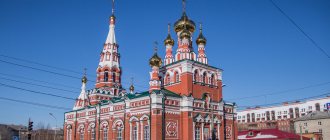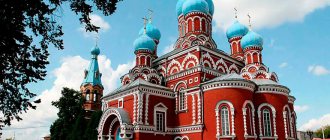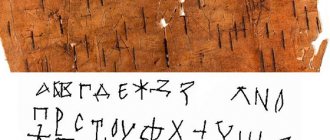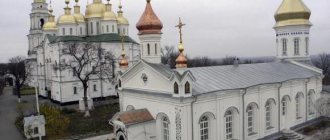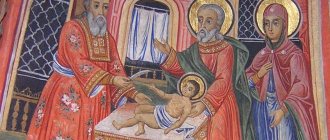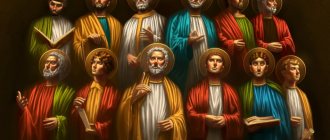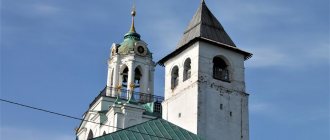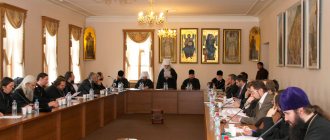| Yoshkar-Ola Annunciation Cathedral. Photo from the site Sobory.ru |
Yoshkar-Ola and Mari Diocese of
the Mari Metropolis of the Russian Orthodox Church
- Diocesan administration: Russia, 424000, Yoshkar-Ola, st. Voznesenskaya, 27
- Tel/fax(fax)
- Official site:
- Canonical territory: GO Yoshkar-Ola, Kozmodemyansk; Gornomariysky, Zvenigovsky, Kilemarsky, Medvedevsky, Orsha, Sovetsky and Yurinsky districts of the republic. Mari El
- Cathedral: Annunciation in Yoshkar-Ola
- On the map: Yandex.Map, Google map
Since the annexation of the Mari region to Russia, most of its territories were part of the Kazan diocese, the north and northeast belonged to the Vyatka diocese, the west to the Nizhny Novgorod diocese.
After 1917, the territory of Mari El was part of the Kazan diocese. In the 1920s-1930s it was included in the Nizhny Novgorod (Gorky) diocese. Since 1926, the see of the Bishop of Mari, vicar of the Gorky diocese, was located in Krasnokokshaisk (now Yoshkar-Ola). The vicariate ended in 1937. In the same year, the parishes of the MASSR again entered the Kazan diocese.
The diocese was formed as an independent diocese by the decision of the Holy Synod of June 11, 1993 in the Republic of Mari El, having been separated from the Kazan diocese.
On October 6, 2021, the Volga diocese was separated from the diocese, after which the city districts of Yoshkar-Ola and Kozmodemyansk were left under the jurisdiction of the Yoshkar-Ola department; Gornomariysky, Zvenigovsky, Kilemarsky, Medvedevsky, Orsha, Sovetsky and Yurinsky districts in the center and west of the republic. At the same time, the Yoshkar-Ola diocese was determined to be the center of the newly established Mari Metropolis.
Historical names
- Mari (vicariate, 1926 - mentioned 1937)
- Yoshkar-Olinskaya and Mariskaya (since June 11, 1993)
Statistics
- November 2011 - 2 monasteries, 90 parishes; 73 parish churches, 2 monastery churches, 54 chapels; 120 full-time clergy (103 priests, 17 deacons; of which monastics: 3 archimandrites, 5 hieromonks, 3 hierodeacons) [1]
- November 2021 - 8 deaneries, 2 monasteries, 97 parishes; 77 parish churches, 2 monastery churches, 44 chapels; 141 full-time clergy (119 priests, 22 deacons; of which monastics: 2 archimandrites, 6 hieromonks) [1]
Historical reference
In 1555, by decree of Tsar Ivan the Terrible, under the Moscow Metropolitan Macarius, the Kazan diocese was established by a conciliar resolution, to which, in the rank of Archbishop of Kazan and Sviyazhsk, the abbot of the Tver Selizharov monastery, Gury (Rugotin), was appointed, who went to Kazan with Archimandrites Barsanuphius and German and the “mandatory memory “: do not involuntarily bring people into baptism, treat people of other faiths meekly, with tenderness, do not inflict cruelty on them, and, if necessary, release them from the court of governors and governors. In hierarchical terms, the Kazan diocese, which belonged to the Moscow Metropolitanate, took third place among the Eastern Russian dioceses after Moscow (metropolitanate) and Novgorod (archdiocese). Since January 26, 1589 - metropolitanate.
Geographically, the Kazan diocese consisted of: in the southwest - up to the Sura River, the Nagornaya Side (Kozmodemyansk, Vasilsursk, Cheboksary, Tsivilsk, Sviyazhsk, Tetyushi) and the Meadow Side (Sanchursk, Tsarevokokshaysk); in the northwest - all lands up to the Vetluga River; part of the Vyatka lands to the middle of the Vyatka River, which since 1658 have been transferred to the newly established Vyatka diocese; in the east - the lands of the Kazan, Astrakhan, and partly Siberian kingdoms (from 1586 Ufa and Birsk included); in the south - the lands of the Astrakhan kingdom to the Tersky town on the Terek River, which from 1602 went to the newly formed Astrakhan diocese. By 1917, the territory of the Kazan diocese was limited to the Kazan province.
From 1922 to 1938 there was a renovationist diocese of the same name.
On June 11, 1993, the Yoshkar-Ola diocese was separated from the Kazan diocese within the Mari El Republic.
On June 6, 2012, independent Almetyevsk and Chistopol dioceses were allocated, after which the northeastern half of Tatarstan remained within the Kazan diocese - the cities of Kazan and Naberezhnye Chelny, as well as Agryz, Apastovsky, Arsky, Atninsky, Baltasinsky, Buinsky, Verkhneuslonsky, Vysokogorsky, Drozhzhanovsky , Elabuga, Zelenodolsky, Kaybitsky, Kamsko-Ustinsky, Kukmorsky, Laishevsky, Mamadyshsky, Mendeleevsky, Menzelinsky, Pestrechinsky, Rybno-Slobodsky, Sabinsky, Tetyushsky, Tukaevsky and Tyulyachinsky districts. At the same time, the Kazan See was designated the center of the Tatarstan Metropolis.
YOSHKAR-OLINSKY AND MARI DIOCESE
Russian Orthodox Church, formed on June 11, 1993 within the borders of the Republic of Mari El by separation from the Kazan and Mari diocese (see Kazan and Tatarstan diocese). The cathedral city is Yoshkar-Ola (in 1584-1919 Tsarevokokshaysk, in 1919-1927 Krasnokokshaysk), cathedrals - the Ascension of the Lord in Yoshkar-Ola, in the name of St. Nicholas the Wonderworker in Volzhsk. The ruling bishop is the archbishop. John (Timofeev; in the department since 1993, since 2004 in the rank of archbishop). The diocese is divided into 5 deanery districts: Yoshkar-Olinsky (Yoshkar-Ola), Gornomarisky (Gornomariysky and Yurinsky districts), Lugovomariysky (Kilemarsky, Orsha, Medvedevsky districts), Volzhsky (Volzhsky, Zvenigovsky, Morkinsky districts), North-Eastern (Soviet, Novotoryalsky, Sernursky, Paranginsky, Mari-Tureksky districts). By Jan. 1 2011 in J.-O. and M.E. there were 88 parishes, 2 monasteries, the clergy of the diocese consisted of 108 priests, 17 deacons.
On July 25, 1993, John (Timofeev) was consecrated Bishop of Yoshkar-Ola and Mari in the church in honor of the Nativity of the Most Holy. Mother of God in the village Semyonovka (currently part of the Yoshkar-Ola urban district), which was in 1960-1993. 2nd Cathedral Church of the Kazan-Mari Bishops. The consecration was led by Patriarch Alexy II of Moscow and All Rus'. Initially, the church in Semyonovka was the cathedral for the Bishop of Yoshkar-Ola, and the diocesan administration was also located here. This was due to the fact that at the time of the formation of the diocese in the capital of Mari El, only a small church in honor of the Resurrection of Christ was operating. In 1995, the department was moved to Yoshkar-Ola.
In 1993-2008 the number of parishes in Mari El increased from 30 to 85, the number of clergy increased almost 3 times (up to 98 priests and 14 deacons). In 1994, Mironositsky was restored in honor of the Image of the Savior of Women Not Made by Hands. mon-ry in the village Yezhov (near Yoshkar-Ola); To celebrate the 350th anniversary of the appearance of the Myrrh-Bearing (see Tsarevokokshaiskaya) Icon of the Mother of God in 1997, a 2-story church was restored in the monastery. after what took place in the Mironositsky Monastery on September 19. 2002, the celebration of the glorification of the new martyrs who suffered for the faith of Christ in the Mari region, the first chapel in the diocese in honor of the new martyrs of Mari was built in the monastery; in July 2008, in the center of Yoshkar-Ola, a monument to the Mari bishop, vicar of the Nizhny Novgorod diocese, sschmch was solemnly opened. Leonid (Antoshchenko). The second monastery of J.-O. and M.E. became built in 1997-1999. Kilemarsky Mother of God-Sergius husband. mon-ry. In Aug. 1998, for the first time since 1928, a procession of the cross took place on the territory of Mari El: from the Ascension Cathedral of Yoshkar-Ola to the Kilemar Pust. The miraculous icon “Appearance of the Most Holy One” was transferred. Mother of God St. Sergius of Radonezh" (at the beginning of the 20th century, the icon was located in the Tsarevokokshay Mother of God-Sergius Monastery, which was closed in 1921). In 1995, worship resumed in the restored Ascension Church. (XVIII century) in Yoshkar-Ola, which received the status of a cathedral. On the site of the Resurrection Cathedral, destroyed in 1961, in the capital of Mari El, the diocese built a temporary prayer building in 1990; in 2010, the temple was completely restored, with a lower church installed. in honor of the Intercession of the Holy. Mother of God. The construction of the Annunciation Cathedral began. The diocese maintains close contacts with the armed forces and law enforcement agencies of the republic; in 1998, bishop. John consecrated the first prison church in the republic in honor of the icon of the Mother of God “Quench My Sorrows.” There are prayer rooms at the city and republican hospitals in Yoshkar-Ola, and a temple was built at the hospital in Volzhsk. Under the Mari State Technical University in 2005, a house church was consecrated in the name of the MC. Tatiana, which received the status of a bishop's metochion. In 2006, the Assumption Church was built on the territory of the Mari El Government House. Currently Currently, there are more than 80 churches and chapels in Mari El, including 10 churches in the capital, 12 churches in the Gornomarisky district. A significant number of former Church buildings in Mari El, especially in the meadow part, are in a dilapidated state.
Church in honor of the Nativity of St. Mother of God in the village Semyonovka. 1818
Church in honor of the Nativity of St. Mother of God in the village Semyonovka. 1818. The diocesan administration has departments: information and publishing, work with youth, social service, interaction with law enforcement agencies and the armed forces, missionary, religious education, as well as a commission for the translation of St. Scriptures in the Mari language, on the canonization of saints.
Gas has been produced since 1996. “Mironositsky Herald” (magazine since 2010), from the end. 90s XX century The Orthodox Church is broadcast on local television. the television program “Transfiguration”; since 2005, the radio program “Blagovest” has been broadcast. Orthodox churches are organized in large cities of the diocese. centers where Sunday schools, libraries, charity canteens, and creative clubs are open. Center employees provide patronage to large families, hospitals, and homes for the disabled. There are 2 brotherhoods in the diocese - Mironositsky in Yoshkar-Ola (founded in December 1993) and the brotherhood of the icon of the Mother of God “Joy of All Who Sorrow” in Volzhsk. Orthodox churches were organized under the Myronositsky Brotherhood. missionary center with a school for Orthodox Christians. teachers, courses for sisters of mercy, courses for catechists and teachers of the fundamentals of Orthodoxy. In 2000, a gymnasium named after St. opened in Yoshkar-Ola. Sergius of Radonezh. Through the efforts of students of the Mari State. university with the blessing of the archbishop. John created a student Orthodox Church. educational club "Vozrozhdenie", which produces gas. "Revival". Since 2003, the diocesan department of religions. Education and Catechesis conducts 3-year courses in which employees of educational institutions are taught basic theological knowledge. Since 1998, as part of the celebration of the Days of Slavic Literature and Culture, the annual scientific and theological conference “Christian Enlightenment and Russian Culture” has been held in Yoshkar-Ola.
Cathedral in honor of the Ascension of the Lord in Yoshkar-Ola. 1756
Cathedral in honor of the Ascension of the Lord in Yoshkar-Ola. 1756 In connection with the widespread spread among the Mari of Orthodox-pagan syncretism (dual faith) and paganism itself, which has a strong position in a number of regions of the republic, primarily in the meadow part (Trans-Volga region), the most important direction of the pastoral activity of the clergy J.-O. and M. e. is missionary work. During a sociological survey in Mari El in 2004, 51% of the population called themselves Orthodox, 12% - two-believers (self-designation), 3-4% - pagans (self-designation - Chimari), 6% - Muslims, 5% were undecided regarding religion , OK. 20% called themselves non-believers. Most pagans and double-believers live in the meadow part of the republic. The overwhelming majority of the Mountain Mari are Orthodox (79% of the inhabitants of the Mountain Mari region called themselves Orthodox, 2% - pagans, 14% - dual-faith). Double believers, along with attending services in the Orthodox Church. in temples they go to perform pagan rituals in “sacred groves”, believing that so. they worship the same God in different ways. Dual faith can be expressed in the complete likeness of pagan deities to the Holy Trinity and the Orthodox Church. saints Thus, the dual-believer Mari identify God the Father with the supreme god Kugu-Yumo (Great God), God the Son with the deity Serlagish (Savior) and with the deity of fate Kugu-Pursho, Holy One. Theotokos - with the goddess of fertility Shochin-Ava-Yumo, St. Nicholas - with the deity of the family, etc. In the representation of the meadow Mari-double believers, St. Nicholas and Presv. The Mother of God, as She is depicted on Her Kazan icon, corresponds to the pagan deities to such an extent that they, like the latter, have servants. Mn. Orthodox holidays merged in the consciousness of the Mari with pagan ones: the Nativity of Christ can be identified with the holiday of Shoryk-Yolom, Easter with the holiday of Kugeche (now this is the Mari name for Easter), etc. Double believers often use St. for magical purposes. water, in front of the icons of saints they sometimes make libations of wine and sacrifice poultry and bread. Among the double-believers, as well as among the pagans, there are many sorcerers, fortune-tellers, and healers.
For the purpose of missionary and educational activities among dual believers and pagans in the 90s. XX century in J.-O. and M. e., which began in the 19th century, was resumed. work on the translation of St. Scriptures and liturgical literature in the national languages of the Mari - Mountain Mari and Meadow Mari. In 1990, the Bible Translation Institute published a Bible for children in the Meadow Mari language, and in 1997 the Four Gospels were published in the Mountain Mari language. Through the works of Archimandrite Varlaam (Semyonov) from Kozmodemyansk in 1994 saw the light of a prayer book in the Mountain Mari language based on the prayer book published in 1892 by Gury of Kazan St. brotherhood, but significantly expanded: plural. prayers, canons and akathists were translated for the first time. In 1993, the prayer book in the Meadow Mari language, published in 1908, was republished.
In 2001, with the blessing of Bishop. John, a translation commission was created at the diocese, consisting of the Mountain Mari and Meadow Mari sections. The main tasks of the commission, like the translation commission of the Orthodox Educational Society in Kazan that existed 100 years ago, are the translation of Orthodox. literature in national languages, as well as missionary and educational activities through the printed word. The Diocesan Translation Commission began its work with the publication of the periodical “Myrrhbearer Ludysh” (Myrrhbearer Reading), a prayer book was printed in the Meadow Mari language (2001, 2005), leaflets were replicated for distribution at religious processions. In 2002, the Psalter was published in the Meadow Mari language. After 3 years of joint work of the Yoshkar-Ola diocesan translation commission with the Finno-Ugric department of the Institute of Bible Translation (Helsinki, Finland), in 2007 a new edition of the translation of the NT into the Meadow Mari language, “U Sugyn,” was published in Yoshkar-Ola. “U Sugyn” is read in some churches during the liturgy, and studied in schools and other educational institutions. In 2009, with the blessing of Archbishop. John, a new version of the translation of the Psalter into the Mountain Mari language was published. Divine services using the Mari languages are performed in a number of rural parishes. Sermons are preached in the Mari languages and teaching is conducted in Sunday schools.
Shrines, religious processions
Myronositsk Hermitage in honor of the Image of the Savior Not Made by Hands in the village. Ezhovo. Photo. 2001
Myronositsk Hermitage in honor of the Image of the Savior Not Made by Hands in the village. Ezhovo. Photo. 2001 In Mari El, the miraculous Tsarevokokshayskaya (Myrrh-bearing) icon of the Mother of God is especially revered, revealed in 1647 on the site where in 1649, at the direction of Tsar Alexei Mikhailovich, the Yezhov-Myrrhnositsky husband began to be built. (now female) mon-ry. The tradition of religious processions with the Tsarevokokshai image has more than 300 years of history. In the 19th century The icon was carried to the cities of Cheboksary and Tsivilsk of the Kazan province, to Yaransk of the Vyatka province, to Ardatov, Alatyr, Kurmysh of the Simbirsk province. After 1917, the revealed Tsarevokokshay icon was confiscated by the authorities. A revered copy of the image was transferred to the Myronositsa monastery, revived in 1994, which, since 1999, has been worn during religious processions in the North-Eastern, Yoshkar-Ola and Lugovomari deaneries. The revered shrine of the Kilemar Mother of God-Sergius is empty. is the miraculous icon “Appearance of St. Mother of God St. Sergius of Radonezh”, transferred to the monastery in August. 1998 from the Ascension Cathedral in Yoshkar-Ola.
Church in the name of St. Gury Kazansky in the village. Petyal. 1896
Church in the name of St. Gury Kazansky in the village. Petyal. 1896 Since 1998, multi-day processions of the cross have been regularly held in all deaneries. In the Volga and North-Eastern deaneries, a religious procession is held annually with a list of the Sedmiezersk Smolensk Icon of the Mother of God, kept in the church in the village. Petyal, Volzhsky district. The Gornomari deanery transfers the miraculous copy of the Vladimir Icon of the Mother of God, kept in the church in the village. Vladimirsky Gornomarisky district. The tradition of religious processions with this image in Kozmodemyansk and surrounding villages has existed since 1654, when the pestilence miraculously stopped; The religious procession was officially established in 1719. Since 2009, in the areas of the Lugovomarisky deanery, a religious procession has been held with the revered icon of the Dormition of the Mother of God from the church in the village. Krasnaya Rechka, Orsha district. Processions of the cross are of great missionary importance, since during the procession church services are held in the marching church and in parish churches. and Mari languages, the sacraments of confession, communion, and baptism are performed. In 1993-2001 in Morkinsky, Sernursky, Mari-Tureksky, Orsha districts of the republic, up to 700 people were baptized during religious processions. annually; Lately up to 40 people have been baptized. annually.
On the territory of the diocese there are at least 10 St. sources. The most famous are the Myronositsky spring near the Ezhovo-Mironositsky monastery and the Kuzhenersky spring in honor of the Great Martyr. Panteleimon on the site of the former. Kuzhenersky Nikolaevsky Monastery. The glory of the miraculous since the 19th century. They also have the Kazansko-Bogorodichny spring near the village. Sovetsky Sovetsky district, Panteleimonovsky spring in the village. Bakhtino, Novotoryalsky district, a source in honor of the Smolensk Sedmiezersk Icon of the Mother of God in the village. Petyal, Michael-Arkhangelsk spring in the village. Chapel of Sernursky district, Nikolsky spring in the village. Nartas of the Mari-Turek district, Nikolsky spring in the village. Court of Medvedevsky district, Alexander Nevsky spring in the village. Aksayevo Gornomariysky district, Iversko-Bogorodichny spring in the village. Upsha, Orsha district. Since 1993, 62 chapels and fonts have been consecrated over springs and springs in the diocese.
From the end XIX century among the Mari both in the territory of J.-O. and M. e., and in the neighboring Vyatka diocese there is widespread veneration of the Mari girl Mary, who was tortured by pagans for converting to Christianity. Above the stone crypt at her grave in the village. Lyadovskaya (Lyadova, now within the city of Sovetsk, Kirov region) there was a wooden chapel; after 1917 it was destroyed, but has now been restored.
Monasteries
Church in the name of Arch. Mikhail in the village. Yurino. 1869–1889
Church in the name of Arch. Mikhail in the village. Yurino. 1869–1889 Operating: Mironositsky in honor of the Image of the Savior Not Made by Hands (female, in the village of Ezhovo, Medvedevsky district, founded in 1649, closed in 1924, revived in 1994), Kilemarskaya Mother of God-Sergius is empty. in honor of the Appearance of the Most Rev. Mother of God St. Sergius of Radonezh (male, between the village of Kumya and the village of B. Pamyaly, Kilemar district, opened in 1999).
Abolished: Bolshe-Yunginskaya Pokrovskaya is empty. (male, at the mouth of the Bolshaya Yunga river, at the residence of the Suzdal bishops, now the village of Pokrovskoye, Gornomariysky district, founded in 1607, abolished in 1764); Novo-Spassky Malo-Yunginsky (male, s. M. Yunga (after 1764) of the modern Gornomariysky district, founded between 1625 and 1627, abolished in 1764); Voznesensky (female, in Kozmodemyansk (now Kozmodemyansk), founded no later than 1655, closed in 1764); monastery in the name of St. Mikhail Malein (male, between the modern settlement of Khmelevka in the Vorotynsky district of the Nizhny Novgorod region and the village of Barkovka in the Gornomarisky district of Mari El, founded in 1671, abolished in 1764, assigned to the Khmelevskaya Trinity male settlement in Vasilgorod (now the village of Vasilsursk )); Chernoozerskaya Troitskaya Vetluzhskaya empty. (male, on the Vetluga river, on the border of the modern Nizhny Novgorod region and the Gorno-Mari region of Mari El, in 1710 assigned to the Kazan bishop's house); Muserskaya Tikhvinskaya is empty. (male, modern village of Mus, Kilemar district, founded no later than 1710, in 1726 assigned to the Kazan Bishop's House as a monastery, abolished in 1764); Ilyinskaya is empty. (male, between the modern village of Tokari in the Gorno-Mari region of Mari El and the village of Ilyinka in the Morgaush region of Chuvashia, founded in 1720, abolished in 1764, assigned to the Malo-Yunginsky monastery); Epiphany (male, in Kozmodemyansk, abolished in 1764); Holy Trinity (female, in Tsarevokokshaisk, abolished in 1764); Sursky Mikhailo-Arkhangelsky (male, on the Sura river, near the modern village of Nov. Sloboda, Gornomariysky district, built in 1868-1871, closed in 1921, revived in 2008); Holy Trinity (female, in Kozmodemyansk, formed in 1887, closed in the 20s of the XX century); Bogoroditse-Sergievsky (women's, in Tsarevokokshaysk (Krasnokokshaysk), founded in 1888 at an almshouse, closed in 1921); Vershino-Sumsky Vvedensky (female, near the village of Vershino-Sumka, now the settlement of the Revolution of the Mountain Mari region, founded in 1898, closed in 1921-1933); Ashtavay-Nyrskaya Nikolaevskaya is empty. (male, near the modern settlement of Oktyabrsky (Ashtavay) Gornomariysky district, founded in 1906, closed in 1921); Kuzhenersky Nikolaevsky (female, near the modern village of Kuzhener, Kuzhenersky district, formed in 1910, closed in 1918).
Church architecture
On the territory of the diocese, 59 churches are classified as architectural monuments of federal significance. The oldest surviving monuments of stone architecture are the Streletskaya Spasskaya Chapel in honor of the Image of the Savior Not Made by Hands in Kozmodemyansk, erected in 1697-1698. (later rebuilt several times), Vladimirskaya Ts. in the village Vladimirsky Gornomariysky district, built in 1713, and Trinity Church. in Kozmodemyansk, built in 1739. In addition to stone churches, a number of monuments of wooden architecture have been preserved, including the oldest wooden church of the region - Pokrovskaya in the village. Kumya, Kilemar district (built in 1866, now in disrepair).
Lit.: Nikanor (Kamensky), Archbishop. Cheremis and their pagan beliefs. Kaz., 1910; Smirnov I. N. Cheremis: Historical-ethnogr. feature article. Kaz., 1889; Romanova S. A. Features of the formation of Orthodox-pagan syncretism of the Mari (XVI-XIX centuries) // History of the Christianization of the peoples of the Middle Volga region: Crete. judgments and evaluation: Interuniversity. Sat. scientific tr. Cheboksary, 1988. pp. 42-48; Levenshtein O. G., Starikov S. V. Orthodox churches and monasteries of the Mari region. Yoshkar-Ola, 2001; they are. 450 years together // Mironositsky Vestn. 2002. No. 10. P. 2; they are. Yoshkar-Ola diocese // Russian monasteries: Volga region. Novomoskovsk; M., 2003. P. 477-503; they are. Orthodoxy on the Mari land // Mironositsky Herald. 2003. No. 7. P. 4-5; Kudryavtsev V.G. Wooden architecture of the Mari. Yoshkar-Ola, 2004; Starikov S.V. History of Orthodoxy. churches in Mari El in the 20th century. on the pages of the Mironositsky Herald (2001-2005) // Mari archeogr. messenger 2006. No. 6. P. 207-213; Mari biogr. encycl. / Author: V. A. Mochaev. Yoshkar-Ola, 2007; Shabykov V.I. Dynamics of religious consciousness of the population of the RME: (according to sociological research 1994-2004) // On the history of interfaith harmony. Yoshkar-Ola, 2007. pp. 113-130; Bazhin V.V. “Under the shadow of God’s blessing” // Mariysk. arch. every year 2009. Yoshkar-Ola, 2009. pp. 246-251.
Diak. Alexander Zhirnov, V. G. Pidgaiko
Historical names
- Kazan and Sviyazhskaya (February 3, 1555 - January 26, 1589)
- Kazan and Astrakhan (January 26, 1589 - 1602)
- Kazan and Sviyazhskaya (1602 - October 16, 1799)
- Kazan and Simbirsk (October 16, 1799 - February 10, 1832)
- Kazan and Sviyazhskaya (February 10, 1832 - mentioned December 14, 1930)
- Kazan and Tatar (mentioned February 25, 1948)
- Kazan and Chistopol (1949 - December 26, 1957)
- Kazan and Mari (December 26, 1957 - June 11, 1993)
- Kazan and Tatarstan (June 11, 1993)
Archpastors
Vicariate of Nizhny Novgorod (Gorkovskoe)
- Arseny (Denisov) (October 2, 1927 - 1928)
- John (Shirokov) (November 17, 1929 - June 15, 1931, August 11 - September 29, 1931)
- Abraham (Churilin) (September 29, 1931 - May 21, 1935)
- Sergius (Kuminsky) (May 21 - May 31, 1935) [2]
- Varlaam (Kozulya) (June 9, 1935 - January 29, 1937)
- Sschmch. Leonid (Antoshchenko) (March 1937 - December 21, 1937 (January 7, 1938))
Independent diocese
- John (Timofeev) (from July 25, 1993)
Web server
| Data center information | |
| AS24940 Hetzner Online AG Nuremberg Bayern Germany 49.4478, 11.0683 | |
| Web server loading time is 0.54 seconds | |
| Domain name servers are ns2.reg.ru (194.58.117.12), ns1.reg.ru (194.58.117.17). Website IP address 144.76.74.166 | |
| IP: | 144.76.74.166 |
| Server type: | Microsoft-IIS/7.5 |
| Encoding: | WINDOWS-1251 |
| PING www.mari-eparhia.ru (144.76.74.166) The packet size is 61 bytes. | |
| 61 bytes for 144.76.74.166: seq_num=1 TTL=58 | 21.8 ms |
| 61 bytes for 144.76.74.166: seq_num=2 TTL=58 | 21.9 ms |
| 61 bytes for 144.76.74.166: seq_num=3 TTL=58 | 20.4 ms |
| — www.mari-eparhia.ru ping results — | |
| 4 requests sent, 4 packets received, 0 lost (0% loss) | |
| The average ping to the server is 16 ms, and the average site load time is 0.54 seconds. | |
| Web server configuration | |
| Cache control: | private,no-cache |
| Content length: | 28404 |
| Content type: | text/html; Charset=Windows-1251 |
| Date of: | Sat, 25 Mar 2021 09:42:45 GMT |
| Expires: | Fri, 24 Mar 2021 09:42:44 GMT |
| Last changes: | 3/25/2017 12:42:45 PM |
| Pragma: | no-cache |
| Web server: | Microsoft-IIS/7.5 |
| X-support: | ASP.NET |
| Adding cookies: | + |
| P3P: | — |
| Miscellaneous: | — |
| E-tag: | — |
| MD5 content: | — |
| Public key pins: | — |
Data are approximate* Last updated: 04/04/2017 09:37:35
Ascension Cathedral. Yoshkar-Ola
The cathedral, which will be discussed further, has been the cathedral of the Yoshkar-Ola and Mari diocese since 1993. Yoshkar-Ola values the Ascension Cathedral as a monument of Russian architecture of the 18th century. The date of its foundation is considered to be 1756. Under Empress Elizabeth Petrovna, it was rebuilt at his own expense by the merchant Pchelin Ivan Andreevich, whose house is still located next to the temple. In 1915, a higher primary school, a secondary school, a parish school and a women's gymnasium were located on its territory. In the early 20s, the clergy of the temple went to the renovationists, but then, at the demands of the parishioners, they offered a prayer of repentance (for this they went to Nizhny Novgorod to see Metropolitan Sergius of Starodsky).
History of creation. Repression
The 19th century is considered very fertile for this land and rich in temple construction. A third of all these structures were created in the period from 1811 to 1829. It was at this time that the future diocese of Mari rebuilt the churches of the villages of Pokrovskoye, Sotnur, Verkhniy Ushnur, Kuknur, Novy Toryal, Semyonovka, Kozhvazhi, Morki, Pektubaevo, Arda, Elasy, Toktaybelyak, Korotni, Arino, Paigusovo.
In the 20-30s, the times of the most terrible repressions began, which closely affected the entire church clergy (both monastics and laity). Powerful waves of destruction and destruction of holy monasteries and temples swept across the country.
In Yoshkar-Ola, the Entry of Jerusalem and Trinity churches were destroyed. Executive bodies, under various pretexts, terminated contracts with religious communities and demanded that all religious buildings be transferred back to them. In 1938-1940, rural churches were closed en masse. According to statistics, in the Mari region before the revolution there were 155 Orthodox monasteries, but then only 9 remained. However, worship in them was also prohibited.
New owners
But then new trials came for the clergy - years of hard times, arrests, exile and executions. In 1935, the temple was handed over to the renovationists, and as a result, in 1937 it was closed, and the rector, Peter Margaritov, was shot. In 1938, the temple was transferred to the radio committee, then there was a beer warehouse in the temple, in 1940 - the Marie Artist partnership, and later its owner was a beer factory. The temple fell into complete disrepair: the drum with the dome, the bell tower, the stone fence were demolished, the wall paintings were destroyed, and a two-story factory building was added.
The life of the parish resumed in the 90s. It was restored, and in 2009 the church bell tower was rebuilt.
Traffic
| A country | Place in countries | Visitors % | Page views % |
| Russia | 64094 | 77.22% | 75.66% |
| Armenia | 170161 | 0.95% | 0.88% |
| Ukraine | 586110 | 3.54% | 3.15% |
| Russia, Armenia, Ukraine are the most popular countries. | |||
| Region | Place in the region | Visitors % | Page views % |
| Average statistics for the last 3 months | ||
| Place in the world | 1,280,815 | +118,988 |
| Monthly attendance | 14,640 | -9.29% |
| Position by monthly traffic | 1,281,820 | +119,081 |
| Page views per month | 61,170 | -4.68% |
| Position by page views | 1,544,162 | +72,267 |
| Page views by 1 visitor | 4.18 | — |
